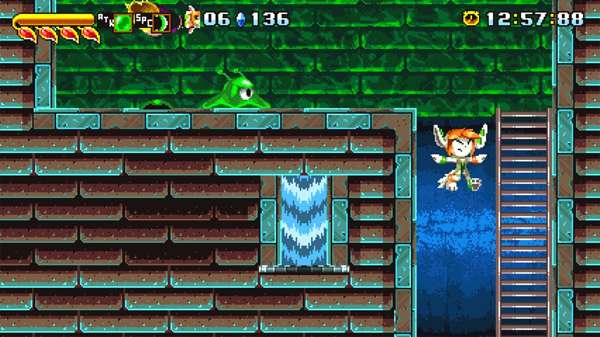
Freedom Planet Switch Review
A single glance at Freedom Planet’s character designs and aesthetic should be enough to clue in most people of what major videogame franchise served as the primary source of information. It would be even less surprising to learn that developer GalaxyTrail had indeed planned to make a fangame based on Sonic the Hedgehog, one out of several thousand already available on the internet. However, after a realization few fan creators ever reach, the team decided to mold their project into an original work rather than falling behind the hedgehog’s shadow (not to be confused with Shadow the Hedgehog).

Even with the rebranded title and revamped designs, Freedom Planet is unmistakably a love letter to Sonic the Hedgehog, but that love also extends throughout Sega’s 16-bit history, as nostalgic fans should be able to spot influences from Gunstar Heroes, Ristar, Nights into Dreams and even Columns. The game’s core structure follows Sonic’s original 2D format, with each stage split into two acts that feature long stretches of platforms, death traps and enemies as well as collectible gems (in place of rings) and power-ups. The playable characters also share similar physics to Sonic in the way that they move and jump, with one character that can roll into a ball while moving. If anyone reading this review is waiting for the part where “That’s where the similarities end” comes up, it won’t happen: the DNA of Sonic is all over this game, one way or another.
Fortunately, Freedom Planet saw fit to only copy everything that made the 2D Sonic games such beloved classics and apply an extra layer of polish and gameplay variety that has never existed in the series. There is a much heavier emphasis on action in Freedom Planet, with each of the three characters possessing an impressive repertoire of moves that can help them defeat enemies and traverse seemingly unreachable platforms. Take Lilac, the half-dragon girl who can kick and punch in all sorts of directions and can also spin her body into a cyclone; her most useful attack is the ability to temporarily burst into a blazingly fast dash that can move in any direction, even in the air. The duration of the dash is indicated by a recharging meter that needs to cool down every time it is used, but it can also bounce between walls. If players can get the angle right, Lilac will be able to reach just about any area no matter how high up it may seem, and with secret collectibles littering every nook and cranny, it serves to constantly experiment with the dashes…. plus, it looks cool when used against a particularly tough enemy.

As expected, Freedom Planet has a lot of boss battles, and they are all impressive to look at as they are tricky to defeat. Once again paying homage to Sega’s finest 2D action games, bosses are typically massive and dish out lots of punishing attacks, with some encounters going into some surprisingly epic places, including a few battles where the player character is added by their comrades in an all-out team attack. This is further enhanced by a truly fantastic soundtrack that manages to evoke the feelings of Sega’s 2D titles while also sounding significantly higher quality. The game also features full voice acting and cutscenes that won’t exactly win awards but is nevertheless full of charm and personality…as well as a few surprisingly dark turns (main villain Brevon is a significantly crueler antagonist than Dr. Eggman despite sharing similar campy traits). The visuals are also some of the most expertly crafted “throwback” graphics ever seen…too many Indie games fail to properly convey the look of whatever generation they are hearkening back to, but Freedom Planet captures the 16-bit Sega motif perfectly, and every character and enemy features lots of gorgeous sprite work and animation. Even though there are a couple of “OC Do Not Steal” duds in the bunch (Torque and Spade, specifically), it’s hard not to crack a smile when the trio of girls show their excitement over an all-you-can-eat sushi buffet.
It is difficult to convey in words just how good Freedom Planet looks and plays without actually experiencing it; the feeling of controlling a character in a game as fast-paced and thumb-twitching in a game like this is perhaps the most important aspect, and it does not disappoint. In addition to Lilac, there are two other playable characters with completely different moves: Carol the cat lacks Lilac’s attack variety but is more maneuverable, especially when she gets ahold of her physics-defying motorcycle (which can scale up walls and even double jump). Milla the dog is the weakest and slowest of the three but can conjure up blocks out of thin air that deal massive damage as well as bust out a shield that repels most attacks. She can also use her long ears to temporarily float upwards, reaching greater heights than either of her two cohorts. All three characters play differently but all control perfectly, and there are even some stage and story differences between the three that encourage numerous replays.

Retro-styled Indie games are all too common these days, almost as much as fan-made Sonic games. Freedom Planet, however, manages to be a cut above both categories while still eliciting those same feelings of nostalgia that too many games rely heavily on, not to mention some of the most refined and entertaining 2D gameplay seen in any generation. The Switch port is also as perfect as it can be, with no slowdown or load times of any kind even in handheld mode. It’s been a great few years for 2D Indie titles, and with a major console port and a sequel on the way, one can only hope Freedom Planet will receive further acclaim and attention than its original PC release in 2014.
